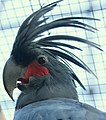Palm Cockatoo
From Wikipedia, the free encyclopedia| Palm Cockatoo | ||||||||||||||||
|---|---|---|---|---|---|---|---|---|---|---|---|---|---|---|---|---|
 | ||||||||||||||||
| Conservation status | ||||||||||||||||
| Scientific classification | ||||||||||||||||
| ||||||||||||||||
| Binomial name | ||||||||||||||||
| Probosciger aterrimus Gmelin, 1788 | ||||||||||||||||
 Australian Palm Cockatoo range (in red) | ||||||||||||||||
| subspecies | ||||||||||||||||
| P. a. aterrimus |
The Palm Cockatoo (Probosciger aterrimus), also known as the Goliath Cockatoo, is a large smoky-grey or black parrot of the cockatoo family. It is the only member in subfamily Microglossinae and the only member of the monotypic genus, Probosciger. Its unique position within the cockatoo family has been confirmed by molecular studies (Brown & Toft, 1999, Astuti, 2004?).
The Palm Cockatoo is distributed in rainforests and woodlands of New Guinea and northern Queensland, Australia.
Description
It measures around 55-60 cm (22-24 in) in length and weighs between 500-1,000 g. It is a distinctive bird with a large crest and has one of the largest bills of any parrots (only the Hyacinth Macaw's is larger). This powerful bill enables Palm Cockatoos to eat very hard nuts and seeds that other species have difficulty accessing. The bill is unusual as the lower and upper mandibles do not meet for much of its length, allowing the tongue to hold a nut against the top mandible while the lower mandible works to open it. The Palm Cockatoo also has a distinctive red cheek patch that changes colour when the bird is alarmed or excited.
Behaviour
Calls
The Palm Cockatoo makes four different kinds of vocalisations, including a "hellow" call that is surprisingly human-like. There are distinct dialects throughout the species' range. It has a unique display where the bird (typically the male) drums a large branch against a dead bough or tree, creating a loud noise that can be heard up to 100 m away. It is possible that females can assess the durability of the nesting hollow by the resonance of this drumming display.
Breeding
Palm Cockatoos only lay one egg and have one of the lowest breeding success rate reported for any species of parrot (Murphy et al. 2003). Off-setting this is their very long life-span. Captive Palm Cockatoos can live up to 90 years of age, but wild Palm Cockatoos are thought to live up to 40-60 years of age (Heinsohn et al. 2009, in press). Breeding takes place inside tree hollows, which are typically like standing pipes. Fires play an important role in the destruction and creation of nest hollows. Fires allow the colonisation of microorganisms and termites which enter the tree and start hollowing out the inside. Cyclones are important in the final stage of nest hollow development.
Status
The Palm Cockatoo is still relatively common in Cape York, but is threatened there by habitat loss, particularly bauxite mining around Weipa and altered fire regimes elsewhere. Palm Cockatoos are hunted in New Guinea. This species is in high demand for the pet trade due to its unusual appearance. The Palm Cockatoo is currently evaluated as Least Concern on the IUCN Red List of Threatened Species. It is listed on Appendix I of CITES.
OUR MISSION
Bali Animal License can provide you the license for conservation needs legally from Central Natural Resource Conservation Bali. We can also provide you suggestions involving the type of conservation including designs of the area, cages, environmental that support the animal lives, protections and health maintanance. Working with Central Natural Resource Conservation Bali we would like to make Bali not only tours destination but also a conservation animal island. With a peacefull nature, community and Hindu's phylosophy of life, Bali will be a perfect island to preserve endangered animals and species in the form of animal conservations.
As an island full of wonderfull nature and culture, Bali becomes one of the favorite tourist destination in the world. With these conditions, Bali could be a place where people not only comes to see the wonderfull nature of Bali and learn the culture, but also invite people to be care with endangered species and have knowledges about them so people will have a new paradigm and spirit to save and preserve extinct species in this planet.
Kakatua Raja
Dari Wikipedia bahasa Indonesia, ensiklopedia bebas
| Kakatua Raja | ||||||||||||||
|---|---|---|---|---|---|---|---|---|---|---|---|---|---|---|
 | ||||||||||||||
| Status konservasi | ||||||||||||||
| Klasifikasi ilmiah | ||||||||||||||
| ||||||||||||||
| Nama binomial | ||||||||||||||
| Probosciger aterrimus (Gmelin, 1788) |
Kakatua Raja atau dalam nama ilmiahnya Probosciger aterrimus adalah sejenis burung Kakatua berwarna hitam dan berukuran besar, dengan panjang sekitar 60cm. Burung ini memiliki kulit pipi berwarna merah dan paruh besar berwarna kehitaman. Di kepalanya terdapat jambul besar yang dapat ditegakkan. Burung betina serupa dengan burung jantan.
Kakatua Raja adalah satu-satunya burung di marga tunggal Probosciger. Daerah sebaran burung ini adalah di pulau Irian dan Australia bagian utara. Pakan burung Kakatua Raja terdiri dari biji-bijian. Paruh burung Kakatua Raja tidak dapat tertutup rapat, dikarenakan ukuran paruh bagian atas dan bagian bawah yang berbeda. Dan ini berguna untuk menahan dan membuka biji-bijian untuk dikonsumsi.
Walaupun spesies ini terancam oleh hilangnya habitat hutan dan penangkapan liar yang terus berlanjut untuk perdagangan, Kakatua Raja masih sering ditemukan di habitatnya. Kakatua Raja dievaluasikan sebagai beresiko rendah di dalam IUCN Red List. Spesies ini didaftarkan dalam CITES Appendix I.








Tidak ada komentar:
Posting Komentar